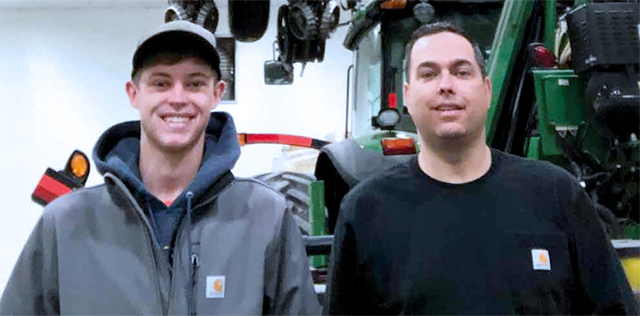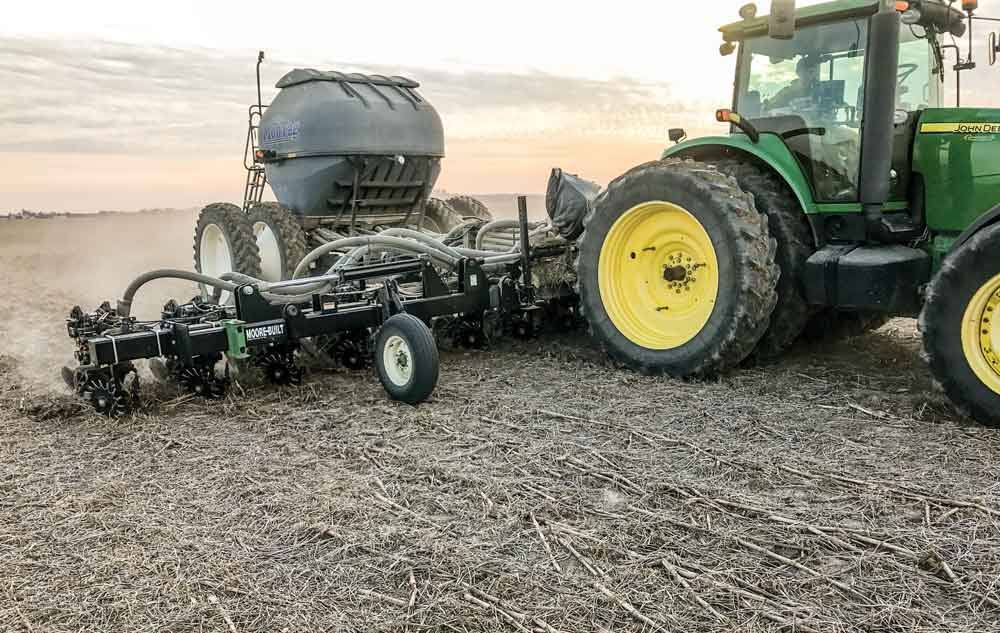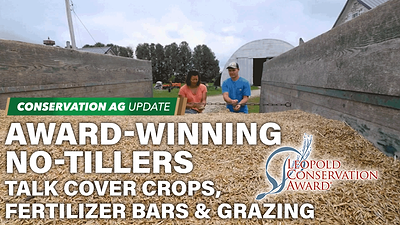Pictured Above: MINIMUM STRIP-TILL. Trent Profit uses a Dawn 6000 minimum disturbance strip-till unit to variable-rate apply a prescription rate of dry fertilizer as determined by soil testing. The disc-style strip-tiller leaves barely a trace in the field compared to the old shank-style machine he originally used.
I WAS BORN into no-till and there’s a running joke I wouldn’t know how to drive a tractor straight if I had to thanks to the family’s quick adoption of guidance technology. That’s what happens when you’re brought up by early adopters and farming innovators. Now it’s my generation’s turn to continue pushing the farm along its upward trajectory.
My father, Dale, and Uncle Charles started experimenting with no-till in the 1980s on the northwest Ohio farm my grandfather started in the 1940s. It wasn’t easy. There was no one else in the area to turn to as they were among the first, but they kept trying. By the late ’80s they had gained confidence and all our soybeans were no-tilled into corn stalks.
Our flat, heavy soils made going 100% no-till a formidable challenge. They settled on the compromise of strip-tilling as they’d seen the value of not disturbing the soil. Strip-tilling allowed them to essentially trick their corn seedlings into thinking they were being raised in a conventionally tilled field while most of the field remained untouched.
Once again, they were somewhat alone in their strip-till adventure. There wasn’t much for equipment on the market, so they built their own strip-till rig — a 12-row shank unit. I graduated high school in 1998. It was my job in the late 1990s through early 2000s to follow the combine with the strip-till unit. I’m still running the strip-tiller, but we’ve since upgraded to a faster unit that disturbs far less soil. It’s one of many newer technologies and strategies we’ve adopted as we continue to push for economic success along with environmental stewardship.

Check The Specs..
NAME: Trent Profit (right, with nephew Alek Bowersock)
LOCATION: Van Wert, Ohio
FARM: Agracola Farms
YEARS NO-TILLING: 40
CROPS: Popcorn, grain corn, seed soybeans and wheat
Follow the Line
Precise, or as close to it as we can get, is our goal for placing seed, fertilizer and nutrients. The same is true for where our tires fall. Strip-tilling, spraying, planting corn or planting beans, we want to stay on the same path.
We’ve used controlled traffic since 2000. It serves to reduce compaction, minimize soil disturbance and get our inputs in the best spot to do their job. We never plant something where we’ve driven equipment and we only place fertility in the zones where plants are growing for maximum efficiency and responsible nutrient use.
Our planter and strip-till bar are both 3-point mounted to provide better control of the equipment and more maneuverability. We adopted the Trimble auto-steer system very early in the game. RTK guidance and auto-steer are critical tools for getting corn planted precisely into the strip where the fertility waits and for precisely planting soybeans.
Soybeans are planted using a 40-foot Great Plains 30-inch twin-row no-till planter. The twins are 10 inches apart. The standard in our area is to plant soybeans on 15-inch rows, which results in two rows of beans wedged between the corn rows. In our fields, we straddle the corn row, placing a row of soybeans just a few inches on either side of old stalks.
This strategy ensures we’re never planting where we’ve driven and that the soils between the rows are never disturbed. Initially, our soybeans seem slower to emerge. But, after a few weeks, our fields look the same as anyone else’s when you drive by.
There are some challenges. Even with guidance, you have to work to keep the corn row perfectly between the twin-row units. There’s also a little more row unit bounce due to the corn stalk residue, which slows down planting.
Another tradeoff we make due to twin rows is running a narrower tire on our Hagie high clearance sprayer. We run a 380/90 RSY (about 15-inch) tire to fit the 22-inch gap between soybean rows. While our soils hold up decently because they’re never tilled where we drive, we do end up with some sprayer tracks in our field when conditions get tough due to the skinny tires.
We address severe rutting when it makes sense, such as when installing tile. In those instances, we plant wheat in the field, harvest, install tile and address ruts, then plant a cereal rye cover crop. However, the further along we come in our minimal disturbance system, the less we seem to notice the sins of years past. Our soils hold up better.
My next challenge for further improving soil structure and health is cover crops. When ruts become a challenge, we do a mulch till and then seed a cereal rye cover crop to help return soil structure faster. I see the soil building benefits and the potential nutrient management benefits, but I’m still working out how to get cover crops into my regular rotation.
Tread Softly
Ohio has recently stepped up efforts to reduce phosphorus loading in Lake Erie, putting forth best practice guidelines and economic incentives. Right now, it’s a freebie. It’s a chance for farmers to adopt these practices, see if they work with their farming system and if they can have an impact on the alga blooms. We’re already using many of the suggested practices. While we hope strict regulations aren’t in our future, we also want to be ready. Plus, we want to do what’s right for the environment.
Banding nutrients with strip-till and rarely putting any nutrients on top of the soil is one of the best practices we’ve followed for decades already. More recently, we developed a farm nutrient management plan.
For the past 8 years we’ve soil-sampled all our acres every other year. Typically, we’re sampling corn stalk fields in the spring to make a variable-rate nutrient plan for our fall strip-till application. We also document everything from the soil sample results to planting, nutrient placement, spraying, etc.
We’re also more careful in the placement of our nutrients. In 2013, we replaced the homemade strip-till unit with a 40-foot Dawn 6000 minimal disturbance strip-till machine. Instead of tearing up the soil with a shank, it uses a coulter to cut a slot, injects fertilizer and then closes the slot. While we still call it strip-till, there’s no more disturbance than what we make with the planter.
“We never plant something where we’ve driven equipment and we only place fertility in the zones where plants are growing…”
The Dawn 6000 can also be used for high speed anhydrous ammonia sidedress applications. We used it to sidedress for 5 years, but in our challenging soils we felt we weren’t getting a perfect seal, which resulted in some vapor loss. As a result, we went back to using a Blu-Jet shank unit for sidedressing anhydrous on popcorn. It creates more disturbance, but seems to do a better job of getting and keeping our N in the soil. We also use N-Serve to stabilize the N and keep it in place longer.
An aNH3 Company EquaRow monitor lets us know immediately if we have a plugged knife and the super cooled controller is supposed to be far more accurate for our variable-rate application.
Precision at planting is also improving. We built our own 45-foot, 18-row planter using John Deere row units on an Orthman toolbar. It has a Precision Planting AirForce downforce system, eSet meters and a 20/20 seed monitor. We’re singulating and placing seeds at a higher rate of accuracy than our previous system, though we could probably do even better with the new hydraulic systems. In 2019, we added a Precision Planting Conceal system to improve accuracy of starter fertilizer placement as well.
Previously we were using a John Deere single disc opener setup to apply starter. There was a coulter that ran at an angle with a shoe that dropped the fertilizer ahead of the row unit. With our planter configuration we felt this setup was cumbersome, causing too much soil disturbance and interfering with seed placement.
The Conceal system integrates a fertilizer knife with the planter gauge wheel for consistent accurate placement of the fertilizer in relation to the seed. Running on the front side of the gauge wheel, it applies starter fertilizer about 1½ inches below the ground and uses a splitter to also place starter 2 inches on either side of the row. Due to the configuration and connection to the gauge wheel, the precise 2-by-2-by-2-inch placement is always achieved no matter if we have row unit bounce or are turning, for example.
This is ideal placement for the growing plant and it’s done with less disturbance than our old fertilizer placement system. It certainly cleaned the planter up, too.
Produce Quality
The crops we grow are also a result of some forward thinking of the past generation. They saw popcorn and seed soybeans — among other crops tried over the years — as niche, higher value crops. While field corn value has caught up, we do still see the value of popcorn and growing seed soybeans. Those crops do require some more intensive management as quality is a significant factor.
On the plus side for seed soybeans, we get access to the latest genetics, the newest traits and we’re able to generate a little more revenue per acre. But there is work involved. Everything is identity preserved, so we must clean our planters, combines, trailers and grain sites.
 PAMPERING PASSES. Trent Profit’s Hagie sprayer gets a lot of work in his highly managed seed soybean fields. Both a fungicide and overlapping herbicide program are used to keep fields clean, healthy and producing the highest quality seed.
PAMPERING PASSES. Trent Profit’s Hagie sprayer gets a lot of work in his highly managed seed soybean fields. Both a fungicide and overlapping herbicide program are used to keep fields clean, healthy and producing the highest quality seed.
Quality is a constant worry. As a result, we have an intensive fungicide management plan to maintain plant health. All acres get at least one fungicide pass. With soybeans, we’ve found making a fungicide application at R3 — with insecticide if necessary — keeps soybeans alive longer to catch late August rains. A longer lived plant produces more seed and larger, higher quality seed.
On soybeans we don’t see benefit to a two-pass fungicide program, plus I get enough sprayer time as it is. I do, however, use a two-pass fungicide program on popcorn. The first fungicide application is made at V5 and seems to help with plant health.
Popcorn hybrids are non-GMO and the genetics generally aren’t as robust as the modern grain corn hybrids. The fungicide gives it a little boost, helping it get up and growing and improving stalk quality. I’m not sure that’s the case in conventional corn. In 2019 I did a strip trial on field corn and it didn’t pay, but it’s a planned pass in popcorn.
At tassel I make a fungicide and insecticide application on all corn acres. This pass keeps the plant healthier longer during the grain fill process, which helps with popcorn quality.
Foliar feeding with our fungicide pass can give us another quality boost in soybeans. We’ve been all over the board with micronutrients and have settled on a shotgun approach. Tissue testing pointed out individual deficiencies that we could then apply, but the whole process was labor intensive. Most recently we started using Brandt Smart Trio as a general micronutrient foliar feeding package. It includes a small amount of urea, sulfur, boron, manganese and zinc.
I’m not convinced foliar feeding pays every year, but I think it can be beneficial when plants are under stress — such as drought or flooding — and can’t access nutrients as effectively through their root system. A foliar feed gives them the opportunity to grab some essential nutrients and get through. Generally, we don’t foliar feed in corn. However, one year we had a field that was very wet between ditches and the corn looked terrible. We added micronutrients to the fungicide application and did see a response.
Double Down on Weeds
Weed seeds are a big issue in seed bean production. We must maintain very clean fields. We’re also concerned about resistant weeds so we favor being proactive in our chemistry program, opting for an overlapping two-pass residual program. For soybeans, first up is a burndown with 2,4-D, glyphosate and Boundary. Our soybean varieties run the gamut from non-GMO to every herbicide tolerance there is to Plenish high oleic beans and our herbicide program reflects those differences. Normally our post emergence application will be Prefix.
On popcorn, we plant it and spray quickly with the glyphosate, Bicept II and Callisto mix. Being non-GMO, we can’t use glyphosate after it emerges. We’re trying for a single-pass program in popcorn, so the longer we wait, the better, which is why we opt to spray after planting.
Quality for popcorn and seed soybeans is also a concern at harvest. Commercial soybeans can be combined at a higher moisture level and dried down in the bin. With seed soybeans, we’re more conscious about combining at an acceptable moisture range of around 12-14%. It’s a challenge, but we keep doing it.
One benefit of popcorn is the lower volume at harvest as compared to grain corn, making the process more cost effective in terms of equipment and labor.
Tweaking Productivity
Besides being good stewards of the soil, we feel it’s important to be good stewards of our time, too. We were underequipped for years. We got the job done, but we did it by spending more time in the tractor seat. Reducing those hours is a focus as we invest in equipment and practices.
Moving from the shank strip-tiller to the high-speed Dawn 6000 was a big jump forward. We moved from 30 feet to 40 feet and whereas the shank machine topped out at 5 mph, the Dawn works at 8 mph on average while disturbing less soil.
We’ve also carved out efficiency at harvest. We purchased a 40-foot John Deere flex draper header for soybean harvest. With the old platform and auger we got more crop wrap. The draper header feeds smoother with less chance for plugging when conditions aren’t ideal and straw is tough. This translates into a faster harvest. From planting to harvest, our windows of opportunity to get field work done are so much shorter these days. Making gains in labor efficiency can make a huge difference in our ability to produce and harvest a good crop.
Generally, we’re quick adopters of technology and want to stay on top of what comes available that is beneficial to our agronomic production or overall profitability. We want to grow our farm but do it in a sustainable way. Plus, land is limited, so if we want to make room for the next generation we have to take care of the acres we have while also pushing them to the highest levels of profitability. We strive to be good stewards and look forward to our next forward move.






